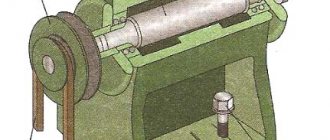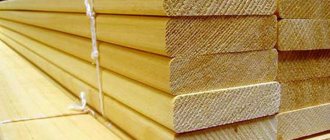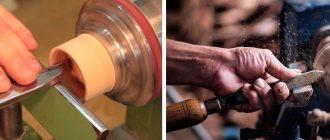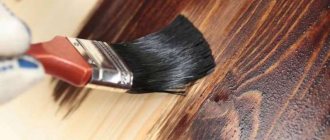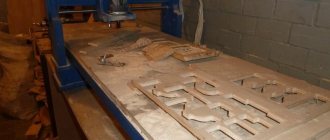A wood lathe can be either very complex and expensive, used on an industrial scale, or adapted for use in a home workshop. Modern lathes can cost from several tens of thousands of rubles to several million dollars. The price depends on their complexity, performance and other technical characteristics. The simplest lathe can drill wood, turn parts from it, and process surfaces. Small models can fit even on the most ordinary balcony of a city apartment.
Any machine consists of certain parts. Its basis is the bed, on which other components are then installed - tail and headstock, caliper, tool holder, control panels and others. This article will discuss the technical characteristics of the machines, their differences from each other and how to choose the right model and what you need to pay special attention to. A couple of useful videos on the topic have been added, and interesting material for downloading has been offered to the reader.
Wood lathe.
Design and principle of operation
The basis of a lathe, including a tabletop one, is the bed. All other nodes are attached to it. Namely, a front headstock (drive chuck) with a rotating spindle, a rear locking headstock and a movable thrust bearing. The task of the driving chuck is to rotate the workpiece. The tailstock securely fixes the part (especially if it is long). The thrust bearing provides the optimal choice of distance to the workpiece.
Securing a part on a lathe can be done in two ways: between the centers of the tailstock and headstock and using a faceplate. The first is the most common option and is used for processing small long bars without end turning.
Here, high precision of fasteners is important so that there is no runout of the part during rotation. For this purpose, an angular center finder is used. The second method is more reliable and necessary if processing of the ends of the workpiece is required. Unlike the previous option, fastening is carried out not with the teeth of the chuck, but with the help of bolts, which hold the part very tightly during all-round turning.
Question to the expert
What is the difference between wood and metal lathes?
The main difference between a woodworking lathe and a similar one for metal is the manual feeding of the cutter (cutting tool, chisel). It is fixed only in one case - when using a copier. The rest of the time, the chisel-cutter is held and controlled by the master manually, partially resting on the thrust bearing. That is, only the spindle rotation speed can be changed automatically.
The entire turning process takes place in two stages. First, roughing is done at an angle of 15-30 degrees, and then finishing is done at an angle of 45 degrees. The thickness of the chips in both operations should not exceed 0.5-1 mm. The design of a wood lathe differs from that of metal lathes in that it does not require a cooling system; therefore, there is no coolant supply system. The power of a manually controlled woodworking lathe is less, but it has adjustable rotation speeds.
The device of a lathe.
To work on manually operated wood lathes that are not intended to produce one type of product, special devices are used - cutters and a removable faceplate. The faceplate serves to securely secure material of the maximum permissible diameter, and the cutter is used for manual work on equipment that does not have a permanently installed support. They are more often used for making simple blanks for painting, turning cuttings needed on the farm for shovels, ax handles and other household utensils.
The school wood lathe gives a complete idea of how you can make household items and beautiful souvenirs. A machine operating at low speeds will allow the novice master to understand the basic operating principle of all turning units and mechanisms. The skills acquired at school will help you master more complex CNC turning equipment. One of the most common equipment in mass production in woodworking shops is a wood turning and copying machine. For its operation, devices are needed - stencils, according to the outline of which the outline of the object will be created.
A device for processing wood from a conventional drill.
History and evolution
Further in the text you will come across technical solutions that are effective, but little known to amateur craftsmen, because... in industry, for one reason or another, they are not used or are used to a limited extent. However, they can simplify and facilitate the manufacture of a homemade lathe for processing wood so much that in some cases it will be possible to limit the use of a power tool to a hand drill. The machine tool industry of the millennium is developing under the sign of solving the problem: how to make machine parts with an accuracy of, say, 1 conventional unit of length on a machine with an accuracy of, say, 0.2 of the same units? Etc. To understand how technology came to such a life, it will be useful to briefly turn to history.
The ancestor of all machines for processing materials by rotation is a device with which Neolithic people made fire and drilled horn, bone, stone, etc. 1 per rice; in the latter cases, an abrasive of wet quartz sand was added under a drill made of wood or bone. The primitive Celts, using the same principle, invented a foot-operated lathe, pos. 2; the centers were made from sharpened, burnt stakes of hard wood. In England, this unit is still used by furniture makers. The forest is not cut down there block by block. Having bought a couple of scaffoldings for felling, the master then carries armfuls of finished legs, balusters, etc. to the track. In a craft of this type, the machine survived for approx. until the beginning of the 18th century, pos. 3, although the workpiece rotates back and forth in it and the master has to be additionally distracted in order to turn the cutter over.
Stages of evolution of the wood lathe
In Ancient Egypt, already in the era of the Middle Kingdom, a lathe with a bow drive was well known, pos. 4. The “motor” was, naturally, the slave. In the Russian village community (in the world), with its strong traditions of mutual assistance and mutual assistance, the bow lathe survived in the outback until... the 80s of the last century! Mass individual wooden construction was in no way included in the five-year plans, but the Soviet leadership in the provinces turned a blind eye to unauthorized logging in limited quantities for their own needs or to unauthorized purchases of wild logs from timber industry enterprises for the universal Soviet currency of 40 volume. and a capacity of half a liter.
For fine and/or small work, a foot machine with a string and a bow machine were not suitable: there are always inhomogeneities in wood, and the workpiece itself was the flywheel - the damper of torsional vibrations. Radical improvements to the lathe were introduced by the master Theodore in Ancient Greece approx. in 400 BC uh, pos. 6. He supplemented the foot drive, firstly, with a crank - now the workpiece rotated in one direction. Secondly, I made the centers rotating and equipped one of them with a grip to hold the workpiece. Thirdly, he introduced a heavy flywheel into the kinematic scheme. Individual machines of this design were in operation at industrial enterprises before the start of electrification of industry, pos. 7 – given the complete absence of social guarantees at that time, the labor of an unskilled helper was cheaper than the cost of maintaining a steam engine.
The electrified wood lathe (item 8 in the previous figure) has remained virtually unchanged since the end of the 19th century (see also figure below):
- a – motor rotor and other massive drive parts do not require the use of a separate flywheel;
- b – the clamping chuck can accommodate various tips for different types of workpieces (see below) or a drill;
- c – a tool rest with a rotating shelf-support for the cutter, mounted on a movable carriage, makes it possible to carry out a wide variety of working operations;
- d – tailstock with a rotating center allows you to bring the processing accuracy to the maximum possible on wood;
- d – the tailstock quill feed screw (see below) makes it possible to carry out complex processing of a workpiece into a part in one installation. During processing, the wood yields under the pressure of the holder and the center. If the tailstock is fixed rigidly, the workpiece becomes loose during processing. The machine has to be stopped and the blanks reinstalled, which in no way contributes to the quality of the work.
Design and kinematic diagram of a modern wood lathe
What if there is no motor?
A non-volatile wood lathe can still be useful today; say, at a dacha or an unequipped construction site. The muscular strength of a normally developed person is sufficient to turn pieces of ordinary timber with a diameter of approx. up to 150 mm. In such a case, 2 options are possible (see next figure): a good old machine with a foot drive (the dimensions of its most important unit, the crank, are given at the top right); For more details about it, see below, and processing on trestles with manually driven tow rope (bottom right in the figure). You can’t round timber to the girth in this way, but it is possible to grind the support pillars of a porch, gazebo or canopy over a barbecue.
Construction of energy-independent wood lathes
“>
Main components
The wood turning machine consists of:
- Beds (the basis for placing the necessary mechanisms and elements).
- Drive chuck (headstock). Responsible for rotating the workpiece.
- Rotating spindle. Adjusts the rotation speed.
- Tailstock. Provides fixation of the part.
- Movable thrust bearing. Sets the optimal distance to the workpiece.
Lathes come in tabletop and bed-mounted types. The frames can be cast iron, stable and durable. There are lightweight cast aluminum frames. Their advantage is the complete absence of corrosion. A desktop (portable) lathe is cheaper. It can also be installed on a special workbench or stand. To do this, the housing must have appropriate mounting holes. A wood lathe can weigh from 18 kg to 90 kg.
What is boxwood How to make a carpentry workbench How to make a table from epoxy resin Impregnation against moisture and rotting
The higher the weight, the less vibration will be felt. It's comfortable. But for home craftsmen, buying large lathes is not profitable. You can get by with a mini machine. The machines also differ in phases. There are two options here - 220 V or 380 V. A single-phase machine is often purchased for the home. It all depends on the network you have. A three-phase lathe is generally more powerful. This is a productive stationary equipment, so it is not needed for rare private work around the house.
Homemade lathe.
The main criteria for choosing a lathe are power and accuracy of processing parts. If turning work is a hobby, then fundamental accuracy is not required. Of course, if the machine can perform fairly accurate work, then this is good. But the price of a functional and very accurate machine is higher.
Often craftsmen working at home take care of silent work. A low-power machine makes less noise. If you choose a lathe from famous and reliable brands, then the very powerful motor is also noise-proof. For more detailed information, we have prepared the most important technical characteristics of lathes. They directly indicate their working potential.
Table of size ranges (standard sizes) of universal wood lathes.
When choosing power, the main thing is to decide what you need the machine for. If for a hobby or “folk art” products, then buy an inexpensive household-grade lathe. These are mini machines. They are ideal for small-scale production. They begin counting their power indicators at 350 W and end at 500 W. For medium-volume work, you should choose a wood lathe with a power of 500 W-1000 W.
The power of a lathe is over 1000 W – this is already relevant for the large-scale industrial sector. Important recommendation: for professional work with heavy loads, choose more powerful machines. Then, when turning or drilling is set to maximum, you will not hear the engine slipping or a drop in speed. But if the motor is weak and does not pull the load, then this has a bad effect not only on the quality of work, but also on the service life of the engine.
Working at a lathe.
Classification of woodworking machines
Many types of equipment are used in the woodworking industry. The main characteristics by which classification is made are the technological process and design features. Technological features:
- Cutting;
- Gluing and assembly;
- Presses;
- Finishing;
- Dryers.
READ How to make a carpentry workbench with your own hands
Equipment of different designs for performing the same operations may differ in operating technology.
- Processing 1 or many items;
- Number of threads;
- 1-axis or 4-axis;
- By the number of spindles;
- Along the trajectory of movement of the processed material;
- By the nature of the presentation.
- By cyclicality.
In addition to the universal lathe, there are several more specialized types of such equipment that are quite in demand in production.
- A screw lathe is designed for cutting threads on a wooden workpiece. In addition, this type of equipment usually processes cone-shaped parts.
- The turning and milling device is designed for the production of various grooves, their boring and subsequent processing.
- A desktop wood lathe is very common among home craftsmen and in educational institutions. Thanks to its light weight and dimensions, this device fits perfectly and is attached to the table top.
- CNC wood processing equipment. This is a separate direction of multifunctional woodworking machines. The main difference between CNC equipment and other types of lathes is their automatic operation, without human intervention.
Woodworking Machine.
Preparing the blank and installing the tool rest
Wood of almost any species can be suitable for processing on a lathe, but the specific choice in each case depends on what kind of part will be created and how it will be processed. Before starting work on the machine, the workpiece must be pre-processed with a plane or an ax, giving it a shape close to cylindrical.
The wooden blank prepared in this way for use is clamped as tightly as possible in the machine before turning it. For his tridents, using a chisel, it is recommended to make small indentations at the ends of the workpiece, which will prevent the workpiece from possibly falling out of the equipment during operation. The support bracket of the tool rest should be installed at a distance of no more than 5 millimeters from the blank and always slightly higher than the axis around which it rotates when working on a lathe.
Processing wood on a lathe.
By placing the tool rest slightly lower than the axis of rotation of the blank, the cutting tool will only scrape the surface of the wood, and not cut it, as it should be. As a result of this work, the surface will become rough rather than smooth. In addition, in this case, the tool may bend under the workpiece, which, quite possibly, will lead to injuries to the one who turns this or that object on the machine.
After every 5-10 minutes of work on the machine, it is necessary to tighten the rear spindle, which will prevent a decrease in the reliability of clamping the blank. As the diameter of the workpiece decreases, the tool rest must be gradually brought closer to its surface.
Using a semicircular and oblique chisel
When giving the blank a cylindrical shape using a semicircular chisel, cutting must be carried out not only with the upper part of the blade, but also with its side parts. In this case, the tool will not become dull so quickly; moreover, the surface being processed will not have a wavy, but an even shape, which will speed up and greatly facilitate all subsequent processing.
When turning smoothly, the jamb should be held in such a way that its blade is located at an angle of 45 degrees in relation to the surface of the cylindrical workpiece. By turning the profile, the jamb can be placed in different positions. Complete trimming of a part on a lathe, as well as partial turning of its ends, is carried out with the sharp end of a cutting tool, which is mounted edge-on on a tool rest.
Using a semicircular and oblique chisel.
How to hold a chisel correctly when working
During operation, the tool must be held on the tool rest bracket with the left hand, using the entire palm. The tool can only be pressed from above using your thumb. It is strictly forbidden for anyone else to touch the support bracket: this can lead to injury. In addition, in this case it will be impossible to move the tool along the workpiece. The right hand should hold the handle of the tool. Thanks to this, when turning, the master can control the direction of movement of the tool.
The workpiece must be secured in the spindles as securely as possible. Otherwise, the blank may fly out of the machine, which may result in injury to the worker. That is why it is forbidden to machine workpieces with cracks at the ends on a lathe.
Some rules for safe work
In addition to the above, danger for those working at the lathe is also caused by a significant distance between the tool rest bracket and the surface of the part, its location below the axis of rotation of the blank, uneven or too strong pressure on the part with the tool. All such deviations from the operating rules can lead to the workpiece being processed flying out of the machine, the tool bending under the part, or to its breakage.
All checks of a part while working with it - measuring its diameter, assessing the smoothness of the surface, checking it with the original, and the like - can only be carried out with the lathe stopped. When sharpening on equipment, it is always recommended to wear safety glasses to protect your eyes from the chips that are sure to form during such work.
Wood turning tool
Most often, turning chisels are used for processing wood on machines. Compared to conventional chisels, turning chisels have longer handles, and their cutters are made only from high-quality tool steel. That is, the chisel consists of two parts - a handle and a metal blade mounted on it with a blade sharpened at a certain angle or a double-edged blade.
There are different types of chisels for different tasks. For a beginner in turning, in order to start working with wood, it is enough to learn how to use these two chisels:
Chisels for turning
- Reyer - this chisel has a semicircular blade, which is made of a thick plate; it is intended for rough turning of the workpiece;
- meisel - this type of chisel is intended for finishing the part; the blade is sharpened obliquely, on both sides.
Most of the other types of turning chisels are classified as shaped tools. They give the final appearance of a turned part. For example, decorative grooves can be cut out on a turned salt shaker. Here are some types of such chisels:
- chisel-hook - with such a cutter you can carve a recess at the end of the workpiece;
- chisel-comb - with its help you can cut internal and external threads or apply many decorative grooves;
- ring chisel - you can do the same thing with it as with a hook.
There are a great many types of shaped cutters. Experienced turners come up with their own cutters for a specific task and make them themselves.
Wood turning cutters
Methods for securing the workpiece
Two methods can be used to secure a part on turning equipment.
- Between the centers of the headstock and tailstock.
- Using a faceplate.
The first method of fastening is the most common. Most often it is used for processing short bars without the need for end processing. With this method of fastening, the accuracy of fastening is of great importance. It is important that when the workpiece rotates, there is no situation of part runout. To eliminate this, use an angular center finder.
Material on the topic: what is wood impregnation.
The second method is more reliable, which is used in cases where processing of the ends of the workpiece is necessary. It differs from the first fastening method in that it is fixed using bolts or chuck teeth. This fastening ensures reliable retention of the part when performing comprehensive turning of the workpiece.
Methods for securing a workpiece on a lathe.
A lathe designed for processing wooden blanks differs from a metal lathe by the presence of a manual feed of the cutter, which is a chisel or other cutting tool for wood. It is secured only if a copier is used. In all other cases, when processing a workpiece, the chisel is held by the master. He also controls it manually, relying on the thrust bearing when performing the operation.
Expert commentary
Ostakhov Alexey Mikhailovich
Practical experience, higher construction education. I talk about repairs and construction in clear language
Ask a Question
The only thing that is done automatically is the spindle rotation speed. The whole process takes place in two stages. First, roughing is performed, which is performed at an angle of 15-30 degrees. Upon completion, finishing is carried out at an angle of 45 degrees. When performing both operations, the chip thickness should be no more than 1 mm.
Tool rest with holder for lathe STD-120
The tool rest with a holder for the STD-120M machine serves as a support for the cutting tool. The tool rest holder consists of a rectangular block with a boss, into the hole of which the tool rest rod is inserted. The tool rest of the STD-120 machine is fixed at the required height and in a certain position with a handle. The tool rest holder is secured to the guides of the STD-120M machine bed with a special screw and a handle through a washer. To work with short and long workpieces, the machine is equipped with two tool rests, 200 mm and 400 mm long.
Bed of lathe STD-120m
The cast iron bed of the STD-120m machine on two legs is installed on a stand and is the base on which the main components of the STD-120M machine are mounted. The front headstock of the machine is fixed to the left of the bed. The holder with a tool rest and the tailstock of the machine are moved along the guides of the frame and secured in a certain position.
Fencing of the cutting zone of the STD-120M machine
The cutting zone fencing on the STD-120m machine serves to protect the worker from flying chips and reduce the concentration of dust generated in the worker’s breathing zone to established sanitary standards. It consists of a metal casing and folding screens.
Devices for installation and fastening of workpieces of the STD-120 lathe
Cutting tools
The machine is equipped with two types of cutting tools: raves and maisols. The rails for the STD-120 machine are a grooved cutter, similar in shape to a semicircular carpenter's chisel. Maisels for the STD-120 machine are cutters that have the shape of a flat chisel with a blade.
Review of mini-lathe models
If you are faced with the task of purchasing a wood lathe for domestic use, then when searching for equipment, the choice should be made in favor of imported models. And the point here is not only that the machines of domestic companies are of lower quality in comparison with foreign analogues. Imported models of wood lathes have a higher power class.
Homemade mini-machine for wood.
They can be used for industrial purposes. The choice of such equipment is quite large. Regardless of the country of origin, most models are assembled in China. Therefore, when choosing such equipment for your workshop, you need to pay attention to parameters such as price, quality and functionality. The best choice would be a machine that has the optimal ratio of these parameters.
READ What is a harvester?
Proma DSO-1000
If we talk about the most affordable model of an imported wood lathe, then this is the Czech unit Proma DSO-1000. Its minimum cost is 6,500 rubles. It has a power of 400 W. It has the ability to adjust the spindle speed in the range from 850 to 2500 rpm. The weight of this machine is 35 kg. It has fairly compact dimensions: 1450x250x370 mm.
Proma DSO-1000.
HolzStar DB450
If you are looking for a machine with an optimal price-quality ratio, then you should pay attention to the HolzStar DB450 model. This Chinese-made machine has a minimum price tag of 12,000 rubles. This mini-lathe is equipped with a frame made of cast iron, due to which vibration is minimal when using it. This means that when performing operations, small parts will be processed with high precision. However, the main advantage of this equipment over its competitors is the high spindle speed. This parameter can be changed in the range from 500 to 3150 rpm. As for the power of the equipment, this machine has this parameter of 370 W. The weight of the machine is 38 kg, and its dimensions are small - 820x300x430 mm.
HolzStar DB450.
JET JWL-1220
Another model worth mentioning is the Chinese JET JWL-1220 lathe. It differs from the models presented above in its high price. The minimum cost of this equipment is 18,500 rubles. However, by paying that kind of money, you get equipment with a large power of 750 W. The main element of this equipment (bed) is made of gray cast iron. A number of important elements of this machine are made from it. Thanks to the choice of such material, vibrations are eliminated when performing operations on this equipment. The engine with which this machine is equipped has 6 speeds and two modes.
When using the first mode, the rotation speed varies from 400 to 3300 rpm. The second has smooth adjustment from 500 to 3900 rpm. This lathe can be easily locked using the quick release lever. The machine is equipped with rubber feet, thanks to which it cannot move during operations. Additionally, with the equipment set, the manufacturer offers a bed extension 710 mm long. As for the weight of this equipment, it is 45 kg.
Table of comparative characteristics of modern models of wood lathes.
Is it worth buying a lathe?
Processing wood on a lathe introduces some restrictions on the shape of the future product; this must be taken into account when choosing mechanical processing. By and large, the product produced on the machine will consist of a combination of rotating bodies, but usually this is quite enough. You can also use the machine to make wooden balls and plates.
Interesting read: what is bakelite plywood.
As for buying a machine, there are both strengths and weaknesses in this decision:
- on the one hand, we get a device that will allow us to significantly increase the speed of wood processing. Products on a wood lathe will reduce the cost per unit of production precisely by saving time;
- Its advantages include the fact that it can cope with soft metals. Much, of course, depends on the manufacturer and the materials used;
- Modern machines come in a wide range of dimensions, so you can choose the right option for both a small workshop and personal use.
The downside may be the price of a new machine, especially if woodworking is more of a hobby than a main source of income. You can save a little by searching for old Soviet models, but the cost will still remain decent. If you want to purchase a lathe as an experiment, just to try your hand at turning wood, but finances do not allow it, then you can try to make a lathe yourself.
Of course, it will not be possible to create a full-fledged analogue of the factory model, but it is quite suitable for processing small workpieces made of soft wood. Small wooden products on a lathe made in-house can easily compete with those made on a machine from a reputable manufacturer.
Optional equipment
You can purchase a number of additional accessories for the machine that will make working with wood easier. Thanks to them, it will be possible to easily process long workpieces without fear of it sagging in the center. A trident for a wood lathe allows you to eliminate the rotation of the workpiece around its axis when the cutter removes chips. Externally, such a device looks like a crown with sharp teeth along the edge; a sharp spike can be placed in the center, but there are tridents and simply with teeth along the edge.
Sometimes it becomes necessary to process a long workpiece, for example, when making balusters for a staircase. In this case, securing it at the ends is not enough; you will need 1 more support in the center, which will not interfere with rotation.
For this purpose, a steady rest for a wood lathe is used. The steady rest is a ring with 3 rollers, their position is adjustable depending on the diameter of the workpiece. Theoretically, they should not interfere with rotation, but with strong compression, quite visible marks from the passage of the rollers remain on the wood. So we can recommend that after roughing, finishing is carried out without a steady rest, if possible.
Note! You can make a steady rest with your own hands.
The main difficulty is to find suitable rotating parts; they must be durable, not leave marks on the wood and wear-resistant. The optimal solution for a homemade steady rest can be considered wheels from ordinary roller skates. When you need to make a large number of similar products (the same balusters for a staircase), it is almost impossible to do this manually.
The cutter path will be slightly different each time, which will affect the shape of the product. The solution to this problem can be a copier for a wood lathe; it allows you to guide the cutter along the same path every time. It is also important that its design is simple, so you can make a good copier yourself.
Wood lathe.
This becomes possible thanks to the use of 2 movable carriages, the lower one moves along the workpiece, the upper one can move in the transverse direction. A wood cutter is installed on the upper carriage, and a small wheel is placed on it to move along the guide slot.
You can turn a regular lathe into a wood lathe to make balls. To do this, you will need a special device in the form of a rigidly fixed cutter and a lever that will allow you to move this cutter along an arc of a certain radius (it is desirable that the radius can be changed).

